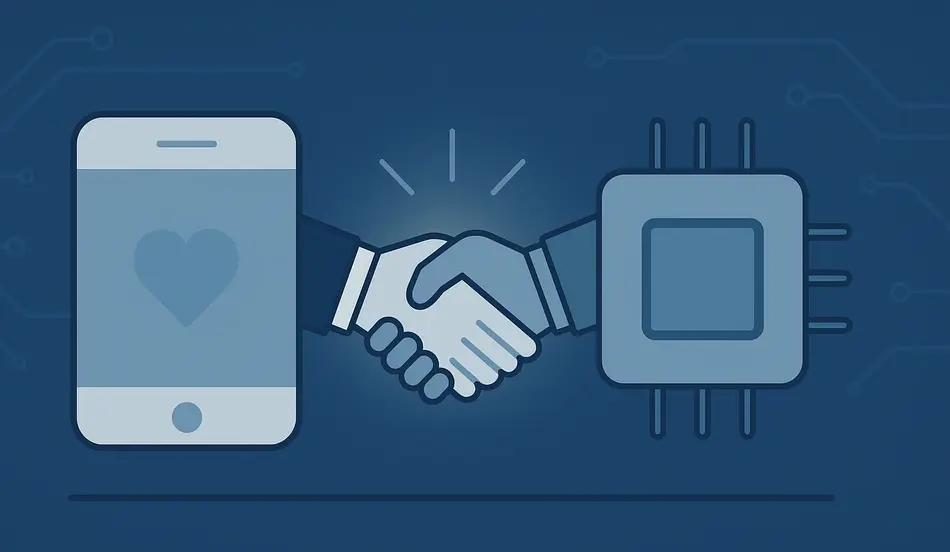Apple and Intel investment talks – this is the breaking news that could fundamentally reshape the technology landscape and create unprecedented opportunities for job seekers and tech professionals. Bloomberg’s Ryan Gould has reported that Apple and Intel are in early discussions around a potential multibillion-dollar investment, marking a significant shift in how these tech giants approach collaboration and innovation.
This development comes at a critical moment in the semiconductor industry, where Intel is actively seeking partnerships to shore up its balance sheet and demonstrate its readiness to compete in the AI era. With Apple already committed to investing $600 billion in the United States over a four-year period, this potential partnership represents a strategic alignment that could create thousands of new jobs and reshape entire sectors of the economy.
The Breaking News: What We Know So Far
According to Bloomberg’s exclusive reporting, Apple and Intel are in early-stage discussions about a potential investment that could involve multiple billions of dollars. While specific numbers haven’t been disclosed, the scope is expected to be significant, given Apple’s massive balance sheet and its existing commitment to invest $600 billion in the United States.
The talks are described as “early stage,” meaning the details are still being worked out. However, the potential areas of collaboration could include:
• Chips and semiconductor manufacturing
• Advanced packaging technologies
• AI infrastructure development
• Supply chain optimization
• Research and development partnerships
Apple & Intel: A Billion-Dollar Collaboration?
With Apple and Intel exploring multi-billion-dollar investments in chips, AI, and supply chain innovation, the tech landscape is on the brink of major change. Employers can stay ahead by building teams ready to innovate in semiconductors, AI, and advanced manufacturing. Post your job on WhatJobs today and connect with top tech talent driving the future of innovation.
Post a Job Free for 30 Days →This isn’t just about money—it’s about strategic alignment between two of the world’s most important technology companies, with implications that extend far beyond their immediate business interests.
Intel’s Comeback Strategy: Proactive Partnership Building
Intel’s outreach to Apple represents a proactive approach to shoring up its balance sheet and demonstrating its readiness to compete in the modern tech landscape. This comes on the heels of significant investments from other major players, including a $5 billion investment from investors earlier this month and a $2 billion pledge from SoftBank.
The company is clearly positioning itself as a serious player in the AI and semiconductor space, showing the US government—one of Intel’s largest shareholders—that it’s ready to explore all available options for growth and innovation. This strategic positioning is crucial as the semiconductor industry faces increasing competition and geopolitical challenges.
Intel’s approach reflects a broader trend in the tech industry, where companies are increasingly looking to form strategic partnerships rather than going it alone. The complexity of modern technology, combined with the massive capital requirements for semiconductor manufacturing, makes collaboration essential for success.
Apple’s $600 Billion Commitment: A Strategic Framework
Apple’s potential investment in Intel fits within its broader commitment to invest $600 billion in the United States over a four-year period, a pledge made in partnership with the Trump administration. This commitment represents one of the largest corporate investment programs in American history, with implications for job creation, technological advancement, and economic growth.
The partnership with Intel could be a key component of this broader investment strategy, providing Apple with access to advanced semiconductor manufacturing capabilities while supporting Intel’s comeback efforts. This alignment of interests creates a win-win situation that could benefit both companies and the broader economy.
Apple’s investment strategy reflects its recognition that controlling more of its supply chain is essential for long-term success. By partnering with Intel, Apple could reduce its dependence on external suppliers while supporting American semiconductor manufacturing capabilities.
The Semiconductor Industry Context: Why This Matters
The potential Apple-Intel partnership comes at a critical moment for the semiconductor industry, which is facing unprecedented challenges and opportunities. The AI boom has created massive demand for advanced chips, while geopolitical tensions have highlighted the importance of domestic semiconductor manufacturing capabilities.
The industry is also experiencing significant consolidation and partnership activity, with companies recognizing that collaboration is essential for success in the modern tech landscape. The potential Apple-Intel deal could be part of a broader trend toward strategic partnerships in the semiconductor space.
This development also reflects the growing importance of semiconductor manufacturing to national security and economic competitiveness. The US government has made significant investments in domestic semiconductor capabilities, and partnerships like this could help ensure that American companies remain competitive in the global market.
Job Market Implications: Opportunities for Tech Professionals
The potential Apple-Intel partnership could create significant opportunities for tech professionals across multiple disciplines. The collaboration would likely require expertise in:
• Semiconductor engineering and manufacturing
• AI and machine learning development
• Supply chain management and optimization
• Research and development
• Project management and coordination
The scale of the potential investment suggests that thousands of new jobs could be created, both directly and indirectly, as the partnership develops. This could be particularly beneficial for professionals with experience in semiconductor manufacturing, AI development, and related fields.
Opportunities for Tech Professionals
From semiconductor engineering to AI development and supply chain innovation, the Apple–Intel partnership could create exciting new opportunities. Don’t miss your chance to be part of the next wave of tech transformation. Search for the latest tech jobs on WhatJobs and take your career to the next level.
Search Tech Jobs →The partnership could also create opportunities for professionals to work on cutting-edge projects that combine Apple’s design expertise with Intel’s manufacturing capabilities, potentially leading to breakthrough innovations in consumer electronics and enterprise computing.
The Competitive Landscape: How This Changes the Game
The potential Apple-Intel partnership could significantly alter the competitive landscape in the tech industry. By combining Apple’s design capabilities with Intel’s manufacturing expertise, the partnership could create a formidable competitor to other major players in the semiconductor space.
This development could also influence other companies’ strategies, potentially leading to more partnerships and collaborations in the industry. The success of the Apple-Intel deal could serve as a model for other companies looking to strengthen their positions in the semiconductor market.
The partnership could also have implications for Apple’s relationship with other suppliers, potentially reducing its dependence on external chip manufacturers while strengthening its position in the market. This could create new opportunities for innovation and cost optimization.
The US Government Angle: National Security and Economic Policy
The potential partnership has significant implications for US government policy and national security. As one of Intel’s largest shareholders, the US government has a vested interest in the company’s success and its ability to compete in the global semiconductor market.
The partnership could help advance the government’s goals of strengthening domestic semiconductor manufacturing capabilities and reducing dependence on foreign suppliers. This aligns with broader efforts to ensure that critical technologies are manufactured in the United States.
The deal could also support the government’s broader economic policy goals, including job creation and technological advancement. The scale of the potential investment suggests that it could have significant economic impact, both locally and nationally.
The Global Context: Geopolitical Implications
The potential Apple-Intel partnership comes at a time of increasing geopolitical tension in the semiconductor industry. Countries around the world are investing heavily in domestic semiconductor capabilities, recognizing the strategic importance of these technologies.
The partnership could help ensure that the United States remains competitive in the global semiconductor market, potentially influencing other countries’ strategies and investments. This could have broader implications for international trade and technology policy.
The deal could also serve as a model for other countries looking to strengthen their semiconductor industries through strategic partnerships between major technology companies and manufacturing firms.
The Future of Tech Partnerships: What This Means for the Industry
The potential Apple-Intel partnership could represent a new model for collaboration in the tech industry, where companies combine their strengths to create more powerful and competitive offerings. This approach could become more common as the industry faces increasing complexity and capital requirements.
The success of this partnership could influence other companies’ strategies, potentially leading to more collaborations and partnerships across the tech industry. This could create new opportunities for innovation and growth while reducing the risks associated with going it alone.
The partnership could also demonstrate the value of strategic thinking and collaboration in the modern tech landscape, potentially influencing how other companies approach their own growth and development strategies.
Frequently Asked Questions
What are the Apple and Intel investment talks about?
Apple and Intel investment talks involve early-stage discussions about a potential multibillion-dollar investment that could include chips, manufacturing, packaging, and other collaborative areas between the two tech giants.
How much could Apple invest in Intel?
While specific numbers haven’t been disclosed, the investment is expected to be in the billions, based on Apple’s $600 billion commitment to US investment and the scale of other recent investments in Intel.
Why is Intel seeking partnerships with Apple?
Intel is seeking partnerships to shore up its balance sheet, demonstrate its readiness to compete in the AI era, and show the US government that it’s proactive in exploring growth opportunities.
What areas could the Apple-Intel partnership cover?
The partnership could cover chips and semiconductor manufacturing, advanced packaging technologies, AI infrastructure development, supply chain optimization, and research and development collaborations.
How could this partnership affect the job market?
The partnership could create thousands of new jobs in semiconductor engineering, AI development, supply chain management, research and development, and project management across multiple disciplines.
What are the implications for the US government?
As Intel’s largest shareholder, the US government has a vested interest in the partnership’s success, which could advance national security goals and strengthen domestic semiconductor manufacturing capabilities.
How does this fit into Apple’s broader investment strategy?
This partnership fits within Apple’s $600 billion commitment to US investment over four years, supporting its goal of controlling more of its supply chain while investing in American manufacturing capabilities.
A Real-World Example: Sarah’s Career Transformation
Sarah, a 28-year-old semiconductor engineer with a master’s degree in electrical engineering, had been working at a small chip design company for three years when she heard about the potential Apple-Intel partnership. “I was immediately excited about the possibilities,” she explains. “This kind of collaboration between two major companies could create incredible opportunities for engineers like me.”
Sarah had been considering a move to a larger company but was concerned about the competitive job market. “The semiconductor industry is incredibly competitive, and it’s hard to break into the top companies,” she says. “But a partnership like this could create new roles that didn’t exist before.”
When the news broke, Sarah started researching both companies’ technologies and began networking with professionals who had experience in both Apple’s design philosophy and Intel’s manufacturing processes. “I realized that understanding both sides of the equation could make me incredibly valuable,” she explains.
Within six months, Sarah had landed a position at a company that was already working with both Apple and Intel on various projects. “The partnership talks created a lot of excitement in the industry, and companies were looking for people who could bridge the gap between design and manufacturing,” she says.
Sarah’s story illustrates how major industry partnerships can create new opportunities for professionals who are willing to adapt and position themselves strategically. “The key is to stay informed about industry trends and be ready to pivot when new opportunities arise,” she advises.
Position Yourself for the Future of Tech
The potential Apple-Intel partnership represents more than just a business deal—it’s a glimpse into the future of how major technology companies will collaborate and compete. For job seekers and tech professionals, this development highlights the importance of staying adaptable and building skills that can bridge different areas of the industry.
The key to success in this evolving landscape is to think strategically about your career and be ready to seize opportunities as they arise. Whether you’re interested in semiconductor engineering, AI development, or project management, the potential partnership could create new pathways for growth and advancement.




